Bryant park, an 8 acre (3ha) large green oasis at the intersection of 42nd Street and Sixth Avenue is one of the most pleasant parks in Manhattan. Even though the park is bordered by heavily trafficked streets, it is a very relaxing park. It has a simple but effective design, with a large, central lawn surrounded by trees.
From the park you have a great view on some great architectural landmarks, including the former American Radiator Building. Similar to some Parisian parks like
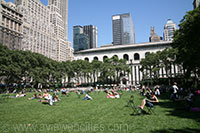 the Jardin du Luxembourg, you can take one of the 2,000 available chairs and sit wherever you prefer.
the Jardin du Luxembourg, you can take one of the 2,000 available chairs and sit wherever you prefer.
Reservoir Square

Reservoir Square
The history of the Bryant Park starts in the 19th century, when it was known as Reservoir square. It was named after the Croton reservoir that was constructed adjacent to the square in 1842. In 1853 the first American World Exposition was held here in Crystal Palace, a magnificent glass construction. Five years later, the palace was destroyed by fire.
In 1884 the square was renamed Bryant Park after
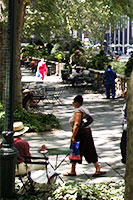 William Cullen Bryant, a poet and lawyer. He was one of the most influential advocates for abolition of slavery in the United States and one of the forces behind the creation of Central Park.
William Cullen Bryant, a poet and lawyer. He was one of the most influential advocates for abolition of slavery in the United States and one of the forces behind the creation of Central Park.
In 1899 the Reservoir adjacent to Bryant Park was demolished replaced by the New York Public Library. As part of this construction which would last until 1911, terraces and kiosks were constructed at the park.
In 1884 the square was renamed Bryant Park after

In 1899 the Reservoir adjacent to Bryant Park was demolished replaced by the New York Public Library. As part of this construction which would last until 1911, terraces and kiosks were constructed at the park.
1930s redesign
After several decades of neglect, the park was redesigned between 1933 and 1934 as part of the depression-era public works project. The competition winning design by Lusby Simpson was implemented by Robert Moses. It featured a great lawn and hedges which obscured the views from the surrounding streets.
Two years later, an iron fence was constructed around the park. This design resulted in a public space virtually cut off from the surrounding city life. You could pass the park unaware
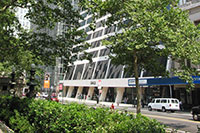
of the activities within. This made it appealing for drug addicts and in the seventies and eighties, the park was shunned by most citizens and tourists.
Two years later, an iron fence was constructed around the park. This design resulted in a public space virtually cut off from the surrounding city life. You could pass the park unaware

View from the park on 42nd Street
1970s to today
In the 1970s the Bryant Park Restoration Corporation was founded by the Rockefeller Brothers. This led to a privately funded redesign and restoration 1988. The redesign by landscaper architect Hanna/Olin and garden designer Lynden B. Miller was aimed towards restoring activity in the park. The high hedges were replaced by shrubs opening the park up to the streets.
In 1992, the new Bryant Park was officially opened and became an instant success. It is now one of New York's most popular parks. In 2002 the park became the
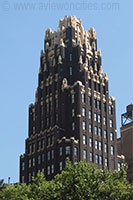
city's first 'wireless park', which means you could connect wireless to the internet from anywhere in the park.
In 1992, the new Bryant Park was officially opened and became an instant success. It is now one of New York's most popular parks. In 2002 the park became the

Bryant Park Hotel
The park contains five statues plus the Josephine Shaw Lowell fountain. Built in 1912 and designed by Charles Adams Platt, this was the first monument dedicated to a woman. Lowell (1843-1905) was a pioneering social reformer. In 2002 a carousel was added to the park.
Surrounding buildings
Bryant Park is hemmed in by some great landmarks. On the east side of the park is the 1911 New York Public Library. The magnificent Beaux-Arts building was designed by Carrere & Hastings. The library's entrance is at Fifth Avenue,
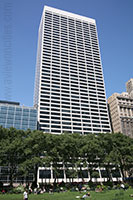
from Bryant Park you look onto the back side of the building.
Another building of interest is the former American Radiator building - now Bryant Park Hotel, a great 1924 skyscraper in neo-Gothic style with Art Deco ornaments. The 22 story tower was designed by André Fouilhoux and Raymond Hood; the latter is also known for the Tribune Tower in Chicago.
Another landmark near the Bryant Park is the 1901 Bryant Park Studios, a building on 40th street in Beaux-Arts style. On the other side of the park is the more modern and larger W.R. Grace building, a sleek 50 story building designed by SOM's Gordon Bunshaft. It was constructed in 1974 for the W.R. Grace chemical company. Adjacent to the W.R. Grace Building is an even larger skyscraper, the 945ft / 288m tall Bank of America Tower, completed in 2009.

W.R. Grace Building
Another building of interest is the former American Radiator building - now Bryant Park Hotel, a great 1924 skyscraper in neo-Gothic style with Art Deco ornaments. The 22 story tower was designed by André Fouilhoux and Raymond Hood; the latter is also known for the Tribune Tower in Chicago.
Another landmark near the Bryant Park is the 1901 Bryant Park Studios, a building on 40th street in Beaux-Arts style. On the other side of the park is the more modern and larger W.R. Grace building, a sleek 50 story building designed by SOM's Gordon Bunshaft. It was constructed in 1974 for the W.R. Grace chemical company. Adjacent to the W.R. Grace Building is an even larger skyscraper, the 945ft / 288m tall Bank of America Tower, completed in 2009.
Комментариев нет:
Отправить комментарий